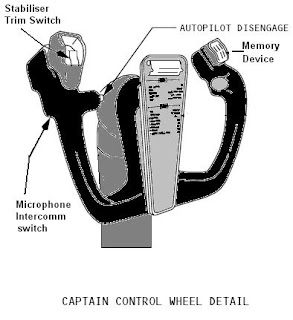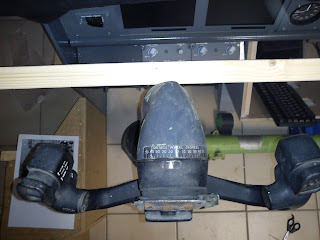
• two control wheels
• two pairs of rudder pedals
• SPEED BRAKE lever
• FLAP lever
• STAB TRIM cutout switches
• STAB TRIM override switch
• stabilizer trim switches
• stabilizer trim wheel
• AILERON trim switches
• RUDDER trim control
• YAW DAMPER switch
• ALTERNATE FLAPS master
switch
• alternate flaps position switch
• FLT CONTROL switches
• flight SPOILER switches
transfer mechanisms which allow the pilots to
bypass a jammed control or surface.
There is a rigid connection between both pairs
of rudder pedals. The SPEED BRAKE lever allows
manual or automatic symmetric actuation of the
spoilers.
powered ailerons and flight spoilers, which are
controlled by rotating either control wheel.
Ailerons
airplane’s longitudinal axis. The ailerons are positioned
by the pilots' control wheels. The A and B
FLT CONTROL switches control hydraulic shutoff valves.
These valves can be used to isolate each aileron, as well
as the elevators and rudder, from related hydraulic system
pressure. The Captain’s control wheel is connected by cables
to the aileron power control units (PCUs) through the aileron feel
and centering unit. The First Officer’s control wheel is connected
by cables to the spoiler PCUs through the spoiler mixer.
The two control wheels are connected by a cable drive system
which allows actuation of both ailerons and spoilers by either
control wheel. With total hydraulic power failure the ailerons can be
mechanically positioned by rotating the pilots' control wheels.
Control forces are higher due to friction and
aerodynamic loads.
Aileron Transfer Mechanism
 |
| Der Linke Schalter dient als "Sicherungs-Schalter". Er muss zusammen mit dem rechten Trim-Schalter betätigt werden. F/O-Side ist es anders rum. |
 |
| Vielen Dank an Markuspilot.com |
Principle
The aviator uses the yoke to control the attitude of the plane, usually in both pitch and roll. Rotating the control wheel controls the ailerons and the roll axis. Fore and aft movement of the control column controls the elevator and the pitch axis.[1]Small to medium sized aircraft, usually limited to propeller driven, feature a mechanical system whereby the yoke is connected directly to the control surfaces with cables and rods. Human muscle power alone is not enough for larger and more powerful aircraft, so hydraulic systems are used, where yoke movements control hydraulic valves and actuators. In more modern aircraft, inputs may be first be sent to a fly-by-wire system, which then sends a corresponding signal to actuators attached to the control surfaces. Yokes may feature a stick shaker which is designed to help indicate the onset of stall, or even a stick pusher which assists in stall recovery.[citation needed]
Styles
| This section does not cite any references or sources. Please help improve this article by adding citations to reliable sources. Unsourced material may be challenged and removed. (May 2010) |
In larger aircraft they are usually mounted on a post protruding vertically from the floor, referred to as a control column. In most other planes they are mounted on a horizontal tube which comes out of the instrument panel.
[edit] Advantages and disadvantages
Side-sticks and joysticks are better for making rapid control inputs and dealing with high g-forces, hence their use in military, sport and aerobatic aircraft. However, yokes are less sensitive thanks to a larger range of motion and provide more visual feedback to the pilot.[2]Yokes take up more room than sidesticks in the cockpit, and may even obscure some instruments; by comparison side-sticks have minimal cockpit intrusion, allowing for the inclusion of retractable tray-tables.[3][4]
A yoke, unlike a side-stick, may be used comfortably with either hand. This can be useful if one needs to write or manipulate other controls in the cockpit. This advantage is shared with the centre-stick [5].
[edit] Ancillary functions
The yoke often incorporates other key functions such as housing thumb or finger buttons to enable the radio microphone, disengage the autopilot and trim the aircraft. Additionally there may be a clipboard, checklist or chronometer located in the yoke's centre.[6][7][8][9][edit] Alternative control systems
| This section does not cite any references or sources. Please help improve this article by adding citations to reliable sources. Unsourced material may be challenged and removed. (May 2010) |
There are also computer input devices designed to simulate a yoke, intended for flight simulators.
Cockpit controls
[edit] Primary controls
Generally the primary cockpit controls are arranged as follows:- A control column or a control yoke attached to a column—for roll and pitch, which moves the ailerons when turned or deflected left and right, and moves the elevators when moved backwards or forwards
- Rudder pedals to control yaw, which move the rudder; left foot forward will move the rudder left for instance.
- Throttle controls to control engine speed or thrust for powered aircraft.
[edit] Secondary controls
In addition to the primary flight controls for roll, pitch, and yaw, there are often secondary controls available to give the pilot finer control over flight or to ease the workload. The most commonly-available control is a wheel or other device to control elevator trim, so that the pilot does not have to maintain constant backward or forward pressure to hold a specific pitch attitude[1] (other types of trim, for rudder and ailerons, are common on larger aircraft but may also appear on smaller ones). Many aircraft have wing flaps, controlled by a switch or a mechanical lever or in some cases are fully automatic by computer control, which alter the shape of the wing for improved control at the slower speeds used for takeoff and landing. Other secondary flight control systems may be available, including slats, spoilers, air brakes and variable-sweep wings.[edit] Basic flight control systems
 |
| Der "Trip-Couter" dient bei einigen Airlines zur Erinnerung an die Flugnummer. |




























Sehr gute Baudokumentation! Großes Lob!
AntwortenLöschenDarf man fragen, woher sie die Jokes bezogen haben ?
Hallo "Anonym",
AntwortenLöschendanke für dein Besuch und dein Interesse an meinem Blog sowie am Simbau!
Die Yokes kommen aus Jarkata/ Indunesien.
Direkt to FlightSim Parts Webshop:
http://www.flightsimparts.com/
Grüße
737NG-info
hello ! i am french!!! i just want to know if you can find a yoke boeing for me please... with the complete column, you or someone other...????
AntwortenLöschenthanks to tell me.
if its possible just tell me
merci beaucoup
best regards
jeros57600@hotmail.fr
Good morning, have sent the answer for you over your email address.
AntwortenLöschenbest regards
737NG-info
Hi there. Nice blog. You have shared useful information. Keep up the good work! This blog is really interesting and gives good details. Stabilizer Manufacturers in India, servo voltage controller stabilizers.
AntwortenLöschenHallo aus Schottland
AntwortenLöschenHabe versucht den link
http://www.flightsimparts.com/
zu nutzen. Der scheint aber tod zu sein. Irgendwelche anderen links fuer Teile?
Danke Ian
Hallo,
AntwortenLöschendie Seite ist super und sehr informativ. Eine Frage zu den Yokes. Welche Höhe (in cm) ist notwendig gewesen, um die linked columns aufzubauen? Eine kurze Info wäre nett.
Danke und Gruß,
Martin
Hallo Martin,
AntwortenLöschenbitte email an: 737nginfo@googlemail.com
Was meinst du genau mit "linked Columns"?
Die Plattform höhe?
Grüße
Patrick
Nice blog. The yoke angle though is wrong, it should lean forward 8 degrees, not 90 degrees.
AntwortenLöschenThat is right, 8 degrees forward if the mashine on ground. The 90 degrees is for builders. best regards
AntwortenLöschenNice post. I learn something new and challenging on sites I
AntwortenLöschenstumbleupon every day. It will always be helpful to read through articles from
other authors and practice a little something from their web sites.
payday loans erie pa
My web page - payday loans arkansas
Hallo,
AntwortenLöschendürfte ich mal fragen, wie viel Geld Sie für alles ausgegeben haben ? Dies Interessiert mich, da ich mir wahrscheinlich auch ein Cockpit der 737 für den FSX bauen möchte .
Good morning to you and thanks for your great blog. Unfortunately I am an amateur flyer myself and do not understand the building process myself. Would there be any way to buy a full and complete set ready to play so to speak? If there is somewhere to find this I would greatly appreciate your help. Danke! Name is Ali from New York, email: shahas101@gmail.com
AntwortenLöschenHi,
AntwortenLöschenNIce and impressive site !
I have a question: can you advice me as to where I aquire old /used 737 components instrumens. Mostly the steering colums and yokes.
Do I have to search in the US or are there closer options?
Great hobby!
Regards/ Erik
Eholck1@gmail.com
Same question as Erik, where can I buy second hand 737 parts? dom.brooks@hotmail.com
AntwortenLöschenHallo, baue gerade selber einen Original Boeing Yoke für den Flusi um. Auf Ihrer Seite steht der Yoke in der Neutralstellung mit 90° senkrecht, aber hat er in der echten Maschine nicht eine natürliche Neigung nach vorn?
AntwortenLöschenViele Grüße
Holger T.
Hallo
AntwortenLöschenIch habe die Höhe der Steuersäule auch von Markuspilot übernommen. Mir erscheint das ganze jetzt nach dem einsetzen in mein HC ziemlich niedrig. Könntest Du mir sagen auf welcher Höhe Dein Yoke Oberkante zum MIP Stand steht?
Danke. Gruss Mike